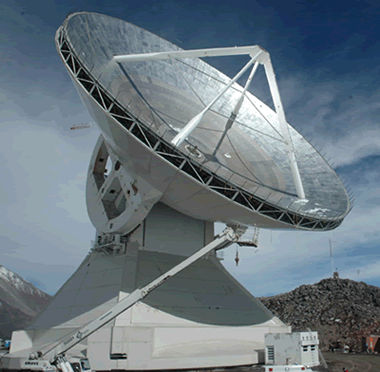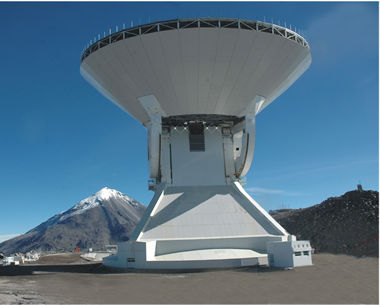The Large Millimetric Telescope (LMT)
The Large Millimeter Telescope Alfonso Serrano was recently inaugurated, this instrument will be optimized within the microwave spectrum region, that is, electromagnetic waves at a frequency of 75 and 300 GHz. (GHz means that there are billions of variations in the electromagnetic field per second, in wavelengths, these would range between 1mm and 4mm, which is why they’re also called millimeter waves -MMW-).
The LMT is a radio telescope with a main antenna of type parabolic of revolution (parabolic transverse section) that has a diameter of 50 meters.
The construction period for the LTM has concluded which makes way for the adjustment process of its instruments. Each one of these instruments is a scientifically designed prototype that has specific objectives. New technologies have also been invented for these instruments, we will see them being applied in different industries, the medical field and in communications. The project is a collaboration between the INAOE and the University of Massachusetts Amherst in the United States. The LTM and its instruments will give the Mexican and International astronomical community new information about the universe.
Overview
The Large Millimeter Telescope (LMT), designed by MAN Technologie, is a 50-m (currently 32-m) diameter single-dish telescope optimized for astronomical observations at millimeter wavelengths (0.85 mm < ? < 4 mm). The LMT Project is a bi-national collaboration between México and the U.S.A. The institutions leading this effort are the Instituto Nacional de Astrofísica, Óptica y Electrónica (INAOE) and the University of Massachusetts at Amherst (UMass) respectively.
A principal scientific goal of the LMT is to understand the physical process of structure formation and its evolutionary history throughout the Universe. More specifically the LMT has the capability to investigate subjects as diverse as the constitution of comets and planetary atmospheres, the formation of extra-solar planets and the birth and evolution of stars, the hierarchical growth of galaxies and clusters and their large-scale distribution, as well as the cosmic microwave background and its anisotropies.
The selected telescope site of Volcán Sierra Negra (lat. ~ +19°), situated ~ 100 km east of INAOE, in the Mexican state of Puebla, is at an altitude of 4,600 m (15,000 ft.) and provides excellent millimeter wavelength transmission throughout the year.
The LMT is an open-air telescope which has been designed to provide a pointing accuracy better than 1 arcsec under median wind-loading conditions (v < 5 m/s). Following the characterization and correction of the telescope surface under the typical deforming effects of the wind, gravity and temperature gradients, an r.m.s. accuracy better than 75 microns has been achieved.
The combination of the atmospheric transmission above the LMT site, the large collecting area of the telescope, and the available field-of-view (up to 8 arcminutes in diameter) provides the LMT with extremely fast mapping-speeds. This advantage is currently exploited by the first-light instruments and, in the following years, by the future suite of instruments that will include a variety of continuum array cameras, heterodyne arrays, and wide-band receivers, and a large flexible autocorrelator spectrometer. An on-going program of instrument development and collaborative access to the telescope for guest instruments will ensure that the LMT remains a leading millimeter-wavelength facility.
New technologies have also been developed for these instruments, we will see them being applied in different industries, the medical field and in communications. The project is a collaboration between the INAOE and the University of Massachusetts Amherst in the United States. The LTM and its instruments will give the Mexican and International astronomical community new information about the universe.
Contact:
|
Dr. David H. Hughes |
|
|
Dr. Miguel Chávez Dagostino |
|
|
Dr. Peter Scholerb |
|
|
Dr. Min S. Yun |
For more information visit: http://www.lmtgtm.org/
Address: Luis Enrique Erro # 1, Tonantzintla, Puebla, Mexico ZIP Code. 72840 Tel: (222) 266.31.00 Contact: difusion@inaoep.mx
This work is licensed under a Creative Commons License Attribution-Noncommercial-No Derivative Works 2.5 Mexico.




